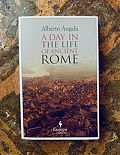
Alberto Angela
A Day in the Life of Ancient Rome
The premise of A Day in the Life of Ancient Rome is as the title suggests: from slightly before sunrise to slightly after sunset the reader is given a walk through the streets and a tour through the buildings of ancient Rome. The year is 115 CE, during Emperor Trajan’s reign. Alberto Angela believes that this was when Rome was at its highest, “when it achieved the greatest expression of its beauty.” The chapters are broken down into hours, explanations and curiosities. The book read quick, with constant fascination for what I would discover next.
For an instant you can relive forgotten worlds; it lets you meet people who no longer exist, and puts you into the middle of daily life as it was lived centuries ago.
Like the apartment buildings the Romans used to live in, the insulae, which were quite similar to our modern ones. Though they were not skyscrapers by our standards—they rarely were taller than six stories—some were skyscrapers back then, and even now, buildings in the center of Rome are on average only slightly taller. On the ground floor of the insulae were shops and taverns and restaurants, another similar feature with the modern day.
Along with the explanations come a few illustrations: Roman women’s hairdos and how to tie a toga. The way the book is organized was extremely effective, working up from small and rather mundane details to the extraordinary. In fact, it was so effective that when I fell asleep after putting the book down, ancient Rome was the setting of my dreams.
It is powerful to think of the world back then, Rome’s massive empire which was centered in Rome. One and a half million people lived here. Earth had never seen anything like it. The Romans had few histories to go from: they wrote the books about how such a civilization functioned and ran. The trial and error must have been enormous, but they succeed for a time, and grandly.
Many of the inventions and social forms instated by the Romans were lost in the middle ages and it was only at the beginning of modern times that “progress” can begin to compare. For example: women received their father’s property and money when he died, giving them financial independence. This freedom was wiped out by the church. The carefully cultivated menus of Roman banquets were lost with the barbarian invasions. The Romans knew the benefits of water for sewers and baths and the rich sometimes had running water in their homes. There were public libraries and gyms.
As for the differences between the ancient Romans and us, Angela explains that they were really not as different as they seem. The eradication of slavery can be attributed to technology: we have toasters and washing machines now, while this labor used to be done by slaves. As for the fights and executions in the Colosseum, the US still employs capital punishment and the bloody spectacle is not so different from our TV shows. The scenes that took place at the Colosseum were disturbing, after reading on those nights, I had nightmares.
It sends a chill down your spine to think that the Colosseum’s four and a half centuries of activity made it the place on Earth where the most people have died in such a small area.
A Day in the Life of Ancient Rome is as historical as any walk through the Eternal City. It has brought that era to life for me in ways that I will often return to. For if I can no longer hear the crowds cheering while walking besides the Colosseum nor see the illustrious marbles of the Forum, at least I have come slightly closer to imagining it.
· · · · · · · · · · · · · · · · · · · ·